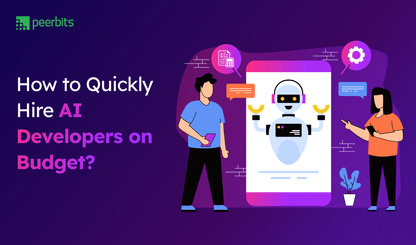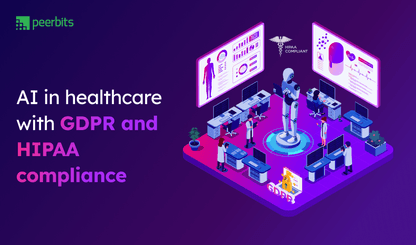It started with prompts and content. Now businesses want Artifical Intelligence that completes workflows instead of just drafts. This gap is exactly what defines the difference between Generative AI vs. Agentic AI and why many teams are rethinking how they build with AI.
Generative AI (Gen AI) works well for producing content. But when your goal is for AI to take action, make decisions, and move work forward across tools and workflows, a new model is needed, that is Agentic AI. It takes action to reach your goal, instead of just responding to prompts.
In this blog, we’ll break down how Gen AI and Agentic AI differ in capabilities, architecture, and business value. You’ll also see where Gen AI falls short, what Agentic AI can actually do in the real world, and what’s required to start building AI systems that go beyond conversation.
GenAI vs Agentic AI: Defined
Before getting into architecture or automation impact, it helps to get the definitions right. Both Generative and Agentic AI are used in business today, but they serve different purposes.
Teams exploring AI development services often start by figuring out which model fits their workflow goals better. Understanding how each type works can make that decision a lot easier.
What is Generative AI?
Generative AI (Gen AI) refers to models trained to create outputs like text, code, images, or audio based on patterns in data. Examples include GPT, Claude, and DALL·E.
These systems respond to prompts. You give them a request, and they return something that looks smart such as summaries, suggestions, or creative drafts.
Think of Gen AI as a helpful assistant. It delivers quality output when asked, but waits for your next instruction to move forward.
What is Agentic AI?
Agentic AI refers to systems designed to take in a goal and carry out the steps needed to achieve it.
These agents can plan tasks, make decisions, interact with tools, adapt to new data, and complete entire workflows without constant input. Whether it's pulling data, running analysis, or updating systems, they continue working until the task is done.
Think of Agentic AI as a project executor. Once it knows the goal, it keeps moving with or without you standing by.
Limitations of Gen AI
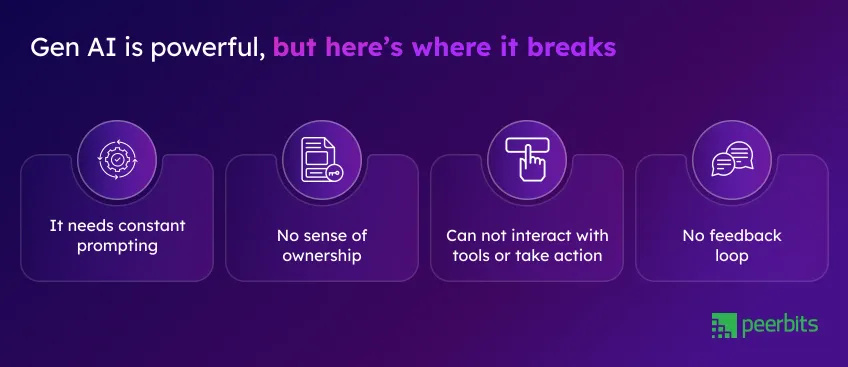
Generative AI has brought solid gains in productivity, especially for teams using Gen AI development services to speed up content creation, writing, and ideation. But once you try applying it across end-to-end workflows, its gaps begin to show. It can generate, but it doesn’t finish the job.
1. It needs constant prompting
Gen AI doesn’t know what to do unless you ask. It operates step by step, always waiting for your next instruction. This makes it reactive, not proactive.
Example: You can ask it to write a proposal and it will. But if the proposal needs revisions, formatting, and sending to a client, it won’t know how to proceed unless you break each step down manually.
2. No sense of ownership
There is no concept of progress or state. Gen AI would not remember what was done in the last session or which stage a task is in. Every time you use it, you start from scratch unless you feed it the full context again.
Example: If you pause while building a strategy deck and return later, Gen AI won’t remember slide structure, feedback notes, or the earlier direction unless you re-enter everything.
3. Can not interact with tools or take action
Generative AI stays inside its chat window. It can suggest what to do next, but it can’t actually perform the action. That limits its value in real workflows where execution matters.
Example: It might tell you how to create a Jira ticket or draft a follow-up email, but it would not log into Jira or Gmail, input the details, and execute the action.
4. No feedback loop
Gen AI does not know if its output worked or failed. It doesn’t learn from results or course-correct unless you manually step in and provide new context. There is no self-check mechanism.
Example: If it writes a summary that misses key points, it won’t know or try to improve unless you point out the issue and feed the corrected information back into the prompt.
Agentic AI: Built for better execution
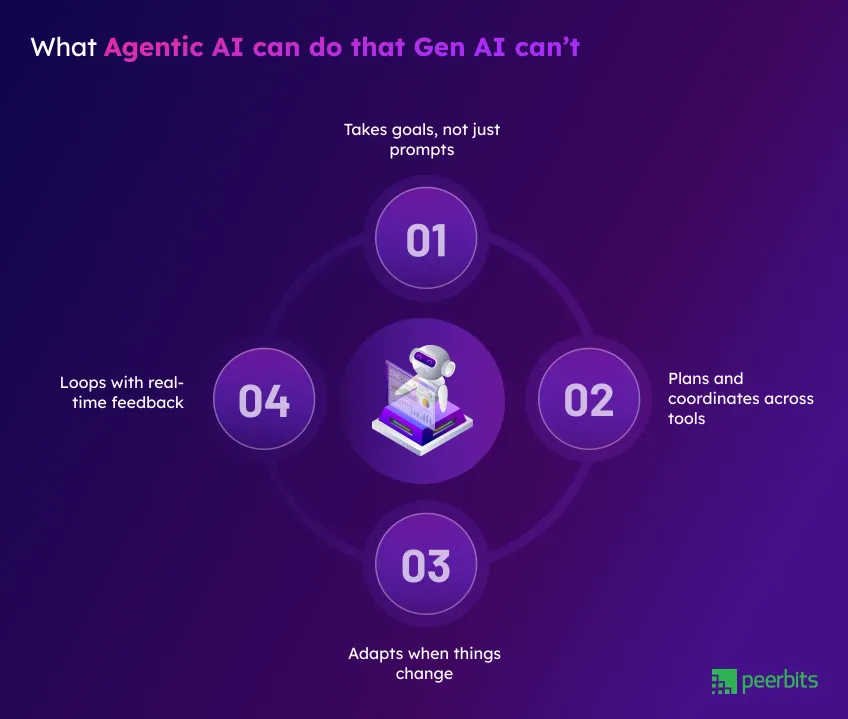
This shift from prompt-based tools to goal-driven agents echoes the concerns raised in The Coming Wave by Mustafa Suleyman, where he explores how unchecked advances in agentic systems pose significant containment challenges both technically and ethically that businesses and governments should consider.
Agentic AI picks up where Gen AI slows down. It does not just assist with ideas, it completes the job. Many businesses are shifting toward AI agent for business models that handle work across tools, make decisions, and adapt without waiting for instructions.
1. Takes goals, not just prompts
Gen AI responds to instructions, but Agentic AI starts with a goal. Give it something broad like "plan next week’s outreach" or "organize signed contracts," and it figures out the steps. This is the key difference between Gen AI and Agentic AI, especially when you want outcomes, not just ideas.
2. Plans and coordinates across tools
Agentic systems talk to CRMs, Notion, Slack, APIs, calendars, and more. It carries out tasks across platforms and can shift between tools if needed. This kind of orchestration is part of well-designed Agentic AI architecture that fits into live business environments.
3. Adapts when things change
Agentic AI is not static. If an API breaks or a needed file is missing, it replans instead of freezing. It tracks progress using memory, adjusts to real-time changes, and keeps the workflow moving. These traits define how modern Agentic AI workflows stay reliable during unexpected disruptions.
4. Loops with real-time feedback
Instead of stopping at output, Agentic AI watches what happens next. If an action fails like a message not sending, it tries again or takes another route. This real-time feedback loop gives it a level of follow-through that Gen AI just can’t match.

Architecture-level comparison: Generative AI vs Agentic AI
If you are planning to build generative AI applications or automate business tasks, it’s important to know the architectural gap between these systems. This helps make smarter tech decisions, especially when comparing Agentic AI vs Generative AI for practical workflows.
| Dimension | Gen AI | Agentic AI |
|---|---|---|
| Trigger | Starts working only when given a user prompt or input | Begins with a high-level goal and figures out next steps without stepwise prompts |
| Memory | Limited to short-term session context, often forgetful between sessions | Maintains long-term memory and can reference past sessions, tasks, or events |
| Task execution | Executes single tasks at a time (like writing an email or summarizing text) | Handles entire task chains involving multiple steps and tools |
| Planning | No internal planning, follows only what the user instructs | Builds dynamic workflows and task trees to achieve outcomes independently |
| Tool use | Can suggest tool usage, but doesn’t operate them | Integrates directly with APIs, CRMs, calendars, databases, and switches tools mid-task |
| Feedback loop | Requires manual checking and new prompts for updates | Acts based on outcomes if something fails, it retries, switches method, or escalates |
| Ideal for | Content generation, rewriting, coding help, creative assistance | Workflow automation, end-to-end execution, ownership of repetitive business tasks |
Companies that are using GenAI vs Agentic AI
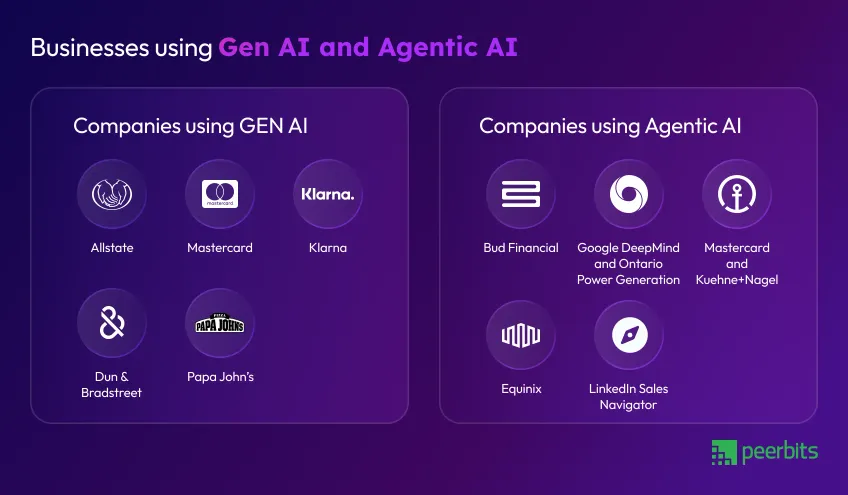
Businesses that started with Gen AI are now shifting toward AI agent development to reduce manual follow-ups and automate full workflows. While Gen AI supports teams with quick content and suggestions, agentic systems are stepping in to actually get things done across marketing, engineering, and operations.
Companies using Generative AI
Allstate
Use case: Allstate employs a generative AI-powered chatbot with natural language processing (NLP) to provide real-time answers to customer queries about coverage in multiple languages. It streamlines the claims process by consolidating relevant information, reducing errors and time spent on forms, though human oversight remains for sensitive cases.
Impact: Improved customer service efficiency and reduced processing times.
Mastercard
Use Case: Mastercard uses generative AI chatbots to deliver quick, relevant responses to customer inquiries, enhancing customer service operations.
Impact: Faster response times and improved customer satisfaction.
Klarna
Use Case: The Swedish FinTech encourages employees to use off-the-shelf generative AI tools like ChatGPT for tasks such as document analysis and drafting contracts. Additionally, Klarna’s custom AI chatbot answers internal process queries.
Impact: Around 90% of employees use AI daily, saving significant time on routine tasks.
Dun & Bradstreet
Use Case: Built an email-generation tool using Google’s Gemini model to create tailored, personalized communications for prospects and customers. They also developed AI-powered intelligent search for complex queries, like identifying companies with high ESG ratings.
Impact: Enhanced sales outreach and improved query resolution efficiency.
Papa John’s
Use Case: Utilizes Google’s BigQuery, Vertex AI, and Gemini models to build predictive tools for anticipating customer orders, enhancing loyalty programs, and personalizing marketing offers. Plans are in place for an AI-powered chatbot to handle orders.
Impact: Improved order prediction accuracy and customer engagement.
Companies using Agentic AI
Bud Financial
Use Case: This banking technology company uses agentic AI to enhance consumer financial management. The AI learns customers’ financial histories and goals, autonomously performing tasks like managing budgets or optimizing savings.
Impact: Proactive, personalized financial services, improving customer outcomes.
Google DeepMind and Ontario Power Generation
Use case: These companies deploy agentic AI in smart grids to optimize energy distribution, balance supply and demand, and detect faults in real-time. The AI adjusts energy storage and redirects power flows for renewable sources like solar and wind.
Impact: Improved grid reliability, operational efficiency, and integration of renewable energy.
Mastercard and Kuehne+Nagel
Use case: These companies use agentic AI in HR to digitize hiring processes, including candidate screening, interview scheduling, and employee retention strategies. The AI evaluates resumes and performance data autonomously.
Impact: Streamlined recruitment and improved employee retention strategies.
Equinix
Use case: Equinix uses agentic AI for partner prospecting and churn prediction. The system scans partner and customer data to identify which accounts to focus on and where churn may happen.
Impact: Helps the team focus on valuable opportunities and act early when customer retention risks are detected.
LinkedIn Sales Navigator
Use case: LinkedIn uses agentic AI to support sales outreach and lead prioritization. The AI tracks changes like job moves or funding updates and drafts personalized messages for outreach.
Impact: Handles large volumes of leads with relevant messaging while reducing repetitive manual tasks for the sales team.
When to choose GenAI for your business?
Generative AI still fits well in setups where speed and flexibility matter more than task ownership. If your operations rely on manual workflows or content-heavy tasks, Gen AI tools can still offer plenty of value.
Choose Gen AI if:
- You need fast outputs for human review or editing
Gen AI responds to prompts quickly, making it useful for drafting content, replying to emails, or summarizing long-form inputs. This is where it excels in content generation roles.
- Your workflows are still manual and linear
When steps are predictable and done mostly by humans, Gen AI supports without disrupting existing processes. In a Generative AI vs Agentic AI comparison, Gen AI performs better in such structured environments.
- You don’t want deep integration into your backend yet
If you're not ready to connect AI into your internal tools, Gen AI works well as a lightweight option. It doesn’t need full system access and works independently.
- You’re doing content-heavy work
Documentation, help center articles, UI copy, product descriptions all of these are areas where Gen AI adds speed without the need for autonomy.
When to choose Agentic AI for your business?
Agentic AI fits best when your team needs more than just answers, when you’re ready for systems that actually do the work. If your tasks involve multi-step logic, real-time tool use, and outcome ownership, this is where agentic models step in.
Shift to Agentic AI if:
- You want to automate workflows, not just generate data
When the goal is action like filing reports, updating tools, or managing workflows Agentic AI moves past suggestions and executes real tasks. This makes it ideal for teams exploring AI workflow automation in their daily operations.
- You’re tired of repeating prompt chains for recurring tasks
Agentic systems can remember what to do and when, without needing prompt-by-prompt guidance. They’re built to handle Agentic AI workflows across tools and tasks with less supervision.
- Your business logic depends on conditions, decisions, and tool coordination
If workflows depend on rules or changes across tools like CRMs, project trackers, and databases, Agentic AI handles branching logic, re-planning, and error recovery.
- You need the AI to act on behalf of the user (not just assist)
Instead of waiting for prompts, these agents take goals like “clean up the sales pipeline” and complete the work from checking records to triggering follow-ups. For companies looking into Agentic AI for business, this offers a serious shift in what AI can handle.
Key components you need to build Agentic AI
Building agentic AI systems goes far beyond plugging in an LLM and calling it a day. While large language models remain a key part of the stack, they’re only one piece of a broader system built for autonomy and execution.
You will need more than just LLMs
LLMs are great for understanding and generating language, but to build agents that can take action and complete tasks, you’ll need supporting components such as:
-
Memory: Store long-term context using tools like Pinecone, Chroma, or Weaviate. This helps the agent remember progress across sessions or tasks.
-
Planning modules: Use task graphs or models like Tree-of-Thoughts to help the AI break complex goals into executable steps.
-
Tool interfaces: Let your agent interact with APIs, browsers, internal tools, or cloud functions. This is what turns it from a passive responder into a true actor.
Core components in an agentic setup
-
Orchestration layer: Tools like LangChain, CrewAI, or AutoGen to manage task flow and role assignment
-
Memory management: Vector databases (Chroma, Pinecone) to store context and decisions
-
Tool interface: Function calling or custom API wrappers to access external systems
-
Monitoring: Observability tools for logs, output validation, and retries
-
Fallback logic: Human-in-the-loop escalation or alert systems in case things go off track
This combination supports a full Agentic AI architecture where decisions, memory, execution, and feedback loops are built in from the ground up.
How Peerbits help? for Agentic AI Development
Building agentic AI systems can be complex, but you don’t have to do it alone. From concept to deployment, our team supports you across every layer of the build.
What we do
-
Understand your business workflows and goals: Let’s start with your use cases, bottlenecks, and automation needs instead of just a generic plan.
-
Map out agent architecture: Whether it’s a single agent or multi-agent setup, we define how tasks are structured, delegated, and executed.
-
Build, fine-tune, and test agents: Our team works hands-on to develop autonomous systems that solve your problems and not just generate content.
-
Integrate with your tools: We connect agents with your CRMs, databases, APIs, and internal dashboards, so they fit into how your teams already work.
-
Support beyond launch: We don’t vanish after delivery. We stay involved through deployment, monitoring, and retraining cycles to keep your systems adaptive.
What makes us different
We’ve worked with businesses that started with basic Gen AI experiments and helped them shift to actual agentic workflows that drive outcomes. We don’t just prototype, we deliver systems built for real-world performance.
Though if you are still unsure what AI suits your business model best, then you can consider AI consulting services before committing to any of the solutions.
Conclusion
Understanding the difference between Generative AI vs. Agentic AI is key when deciding how AI should function in your business. It is about choosing a tool and knowing whether you need fast outputs or full task execution. That clarity helps set the right direction for your automation goals and long-term efficiency.
Gen AI supports fast content creation, summaries, and outputs based on prompts. It's useful when human review is part of the process and tasks are mostly linear.
Agentic AI, on the other hand, moves beyond outputs. It handles end-to-end tasks, makes decisions, connects with tools, and adapts in real time. It's built for ownership and automation at scale.
Clarity around business use cases, architecture, and model suitability supports stronger decisions. For teams building autonomous systems, AI agent development can translate business logic into dependable AI workflows.
Defining how Agentic AI and Generative AI function in workflows helps narrow down the right system for the job. It is a matter of aligning capabilities with the depth of automation a business actually needs.



